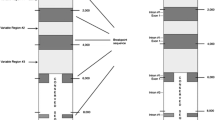Abstract
The gene responsible for the neuromuscular disease idiopathic torsion dystonia (DYT1) has recently been mapped to human chromosome 9q32–34. Our goal is to identify candidate genes for torsion dystonia as well as other neurologically important genes in this region. To accomplish this we have characterized the expression patterns of transcribed sequences identified within a collection of 3000 human 9q32–34-specific clones. Screening of this clone collection with cDNA probes from various brain and peripheral tissues resulted in the identification of 143 clones corresponding to 9q32–34-specific transcripts. Thirty three of these corresponded to transcripts expressed in a brain-specific manner and thus represent preferred candidates for the dystonia gene. None of these candidates were expressed specifically in the putative dystonia target tissue, basal ganglia. The 9q32–34 collection was screened with a subtracted probe enriched in striatal sequences using a directional tag PCR subtraction method. This resulted in the identification of several genes exhibiting preferential expression in the striatum as compared to cerebellum.
Similar content being viewed by others
References
Adams M. D., Kelly J. M., Gocayne J. D., Dubnick M., Polymeropoulos M. H., Xaio H., Merril C. R., Wu A., Olde B., Moreno R. F., Kerlavage A. R., McCombie W. R., and Venter J. C. (1991) Complementary DNA sequencing: expressed sequence tags and human genome project.Science 252, 1651–1656.
Aviv H. and Leder P. (1972) Purification of biologically active globin messenger RNA by chromatography on oligothymidylic acid-cellulose.Proc. Natl. Acad. Sci. USA 69, 1408–1492.
Brison O., Ardeshir F., and Stark G. R. (1982) General method for cloning amplified DNA by differential screening with genomic probes.Mol. Cell Biol. 2, 578–587.
Buckler A. J., Chang D. C., Graw S. L., Brook J. D., Haber D. A., Sharp P. A., and Housman D. E. (1991) Exon amplification: a strategy to isolate mammalian genes based on RNA splicingProc. Natl. Acad. Sci. USA 88, 4005–4009.
Calne D. B. and Lang A. (1988) Secondary dystonia.Adv. Neurol. 50, 9–33.
Carlson M., Nakamura Y., Krapcho K., Fujimoto E., O’Connell P., Leppert M., Lathrop G. M., Laiouel J. M., and White R. (1987) Isolation and mapping of a polymorphic DNA sequence pMCT136 on human chromosome 9q (D9S10).Nucleic Acids Res. 15, 10,613.
Chirgwin J. M., Prybyla A. E., MacDonald R. J., and Rutter W. J. (1979) Isolation of biologically active ribonucleic acid from sources enriched in ribonuclease.Biochemistry 18, 5294–5299.
Danielson P. E., Forss-Petter S., Brow M. A., Calavette L., Douglass J., Milner R. J., and Sutcliffe J. G. (1988) p1B15: a cDNA clone of rat mRNA encoding cyclophillin.DNA 7, 261–267.
Elgar G. S. and Brenner S. (1992) A novel method for isolation of large insert DNA from recombinant lambda DNA.Nucleic Acids Res. 20, 4667.
Goldberg M. I., Lifton R. P., Stark G. R., and Williams J. G. (1979) Isolation of specific RNAs using DNA covalently link to diazobenzlomethy cellulose or paper, inMethods in Enzymology, vol. 68 (Wu R., ed.), Academic, New York, pp. 206–220.
Henske E. P., Ozelius L., Anderson M. A., and Kwiatkowski D. J. (1992) A radiation-reduced hybrid cell line containing 5 Mb/17 cM of human DNA from 9q34.Genomics 13, 841–844.
Hochgeschwender U., Sutcliffe J. G., and Brennan M. B. (1989) Construction and screening of a genomic library specific for mouse chromosome 16.Proc. Natl. Acad. Sci. USA 86, 8482–8486.
The Huntington’s Disease Collaborative Research Group (1993) A novel gene containing a trinucleotide repeat that is expanded and unstable on Huntington’s disease chromosomes.Cell 72, 971–983.
Liang P. and Pardee A. B. (1992) Differential display of eukaryotic messenger RNA by means of the polymerase chain reaction.Science 257, 967–971.
Lovett M., Kere J., and Hinton L. M. (1991) Direct selection: a method for the isolation of cDNAs encoded by large genomic regions.Proc. Natl. Acad. Sci. USA 88, 9628–9632.
Marsden C. D., Obeso J. A., Zarranz J. J., and Lang A. E. (1985) The anatomical basis of symptomatic hemidystonia.Brain 106, 463–483.
Northrop H., Lathrop M., Shu-Ying L., Daiger S. P., Beaudet A. L., and O’Brien W. E. (1989) Multilocus linkage analysis with the human arginosuccinate synthetase gene.Genomics 5, 442–444.
Olson M., Hood L., Cantor C., and Botstein D. A. (1989) A common language for physical mapping of the human genome.Science 245, 1434,1435.
Ozelius L., Kramer P. L., Moskowwitz C. B., Kwiatowski D. J., Brin M. F., Bressman S. B., Schuback D. E., Falk C. T., Risch N., de Leon D., Burke R. E., Haines J., Gusella J. F., Fahn S., and Breakefield X. O. (1989) Human gene for torsion dystonia located on chromosome 9q32–34.Neuron 2, 1427–1434.
Parimoo S., Payanjali S. R., Shukla H., Chaplin D. D., and Weissman S. M. (1991) cDNA selection: efficient PCR approach for the selection of cDNAs encoded in large chromosomal DNA fragments.Proc. Natl. Acad. Sci. USA 88, 623–627.
Rigby P. W. J., Dieckmann M., Rhodes C., and Berg P. (1977) Labeling deoxyribonucleic acid to high specific activityin vitro by nick translation with DNA polymerase I.J. Mol. Biol. 113, 237–251.
Sambrook J., Fritsch E. F., and Maniatis T. (1989)Molecular Cloning: A Laboratory Manual. Cold Spring Harbor Laboratory, Cold Spring Harbor, NY.
Smith M. and Simpson N. E. (1989) Report to the committee on the genetic constitution of chromosomes 9 and 10.Cytogenet. Cell Genet. 51, 202–225.
Travis G. H., Brennan M. B., Danielson P., Kozak C. A., and Sutcliffe J. G. (1989) Identification of a photoreceptor specific mRNA encoded by the gene responsible for retinal degeneration slow (rds).Nature 338, 70–73.
Usui H., Falk J. D., Dopazo A., de Lecea L., Erlander M. G., and Sutcliffe J. G. (1994) Isolation of clones of rat striatum-specific mRNAs by directional tag PCR subtraction.J. Neurosci. 14, 4915–4926.
Author information
Authors and Affiliations
Rights and permissions
About this article
Cite this article
Falk, J.D., Usui, H. & Sutcliffe, J.G. Identification and characterization of transcribed sequences on human chromosome 9q32–34. J Mol Neurosci 5, 165–179 (1994). https://doi.org/10.1007/BF02736731
Issue Date:
DOI: https://doi.org/10.1007/BF02736731




